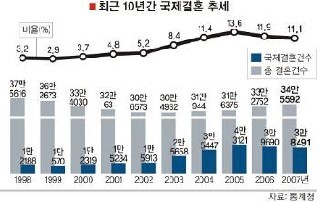hankyoreh
Links to other country sites 다른 나라 사이트 링크
Foreign population grew four times in eight years in S. Korea

New demographic data released yesterday reveals Korea to be a society undergoing a period of rapid change. Not only is the country’s population increasing as a whole, the foreign population has grown fourfold in the last eight years and the number of international marriages has increased 2.5 times from six years ago. As access to high-speed Internet connections has become nearly ubiquitous, the number of clients registering for Internet banking services jumped 13-fold in the last eight years to 52.6 million. In addition, more than nine out of 10 people have a mobile phone. Though worker salaries have increased generally, the statistics show a persistent socioeconomic disparity across occupations and industries.
The National Statistical Office released the new data yesterday as part of its 2008 Society Index.
Last year, the nation’s population increased 0.31 percent from a year ago to 48.6 million. With the number of nuclear families on the rise, the number of households increased at a faster pace than the population as a whole, totaling 16.67 million households recorded at the end of 2008, up 1.56 percent from a year earlier. Out of the 16.67 million households recorded, 3.35 million were one-person households.
The number of registered foreigners rose to some 854,000 people last year, accounting for 1.8 percent of total population. That compares with some 210,000 foreigners residing in South Korea in 2000.
Life expectancy was 79.6 years in 2008, as compared with 74.4 years in 1997. The sex ratio at birth was 106.1 boys to 100 girls, within the normal ratio of between 103 and 107.
The average monthly income for salaried workers increased 4.1 percent to 2.57 million won (US$1,705).
When worker salaries were compared by job type, with the monthly salary of an office worker was bench marked at 100, the monthly salaries of high-ranking executives and managers earned a ranking of 188.9, while laborers came in last at 54.7. When comparing worker salaries by industry, with the monthly salary of a worker in the manufacturing sector bench marked at 100, people working in the electricity, gas and water service industry topped the rankings at 170.9, while workers in the construction, wholesale, retail, food and lodging industries were ranked last at 90.7.
The number of high-school graduates entering university rose to 83.8 percent last year, compared with 64.1 percent a decade ago. The number of students per class was 29.2 in elementary schools, 34.7 in middle schools and 35.1 in general high schools.
Urban housing prices increased 3.1 percent from a year ago, according to the data. The price of a housing unit in a yeonlip jutaek, a residential home with up to four stories and several housing units, increased 7.9 percent. The price of apartments and single-family homes increased 2.3 percent and 2 percent, respectively.
While the number of people using land line telephone service fell 4.3 percent to 22.13 million, the number of mobile phone users rose 4.8 percent to 45.6 million, meaning that 93.8 out of 100 people have mobile phone subscriptions.
The number of people killed in transportation accidents fell by nearly half to 6,166 in 2008, compared with 12,325 deaths in 1990.
The crime rate increased 7.5 percent in 2008 from a year earlier to 1.96 million cases.
Please direct questions or comments to [englishhani@hani.co.kr]
Editorial・opinion
![[Editorial] Does Yoon think the Korean public is wrong? [Editorial] Does Yoon think the Korean public is wrong?](https://flexible.img.hani.co.kr/flexible/normal/500/300/imgdb/original/2024/0417/8517133419684774.jpg) [Editorial] Does Yoon think the Korean public is wrong?
[Editorial] Does Yoon think the Korean public is wrong?![[Editorial] As it bolsters its alliance with US, Japan must be accountable for past [Editorial] As it bolsters its alliance with US, Japan must be accountable for past](https://flexible.img.hani.co.kr/flexible/normal/500/300/imgdb/original/2024/0417/6817133413968321.jpg) [Editorial] As it bolsters its alliance with US, Japan must be accountable for past
[Editorial] As it bolsters its alliance with US, Japan must be accountable for past- [Guest essay] Amending the Constitution is Yoon’s key to leaving office in public’s good graces
- [Editorial] 10 years on, lessons of Sewol tragedy must never be forgotten
- [Column] A death blow to Korea’s prosecutor politics
- [Correspondent’s column] The US and the end of Japanese pacifism
- [Guest essay] How Korea turned its trainee doctors into monsters
- [Guest essay] As someone who helped forge Seoul-Moscow ties, their status today troubles me
- [Editorial] Koreans sent a loud and clear message to Yoon
- [Column] In Korea’s midterm elections, it’s time for accountability
Most viewed articles
- 1[Column] The clock is ticking for Korea’s first lady
- 2Samsung barricades office as unionized workers strike for better conditions
- 3[Editorial] When the choice is kids or career, Korea will never overcome birth rate woes
- 4[News analysis] After elections, prosecutorial reform will likely make legislative agenda
- 5S. Korea, Japan reaffirm commitment to strengthening trilateral ties with US
- 6Why Israel isn’t hitting Iran with immediate retaliation
- 7[Guest essay] How Korea turned its trainee doctors into monsters
- 8Japan officially says compensation of Korean forced laborers isn’t its responsibility
- 9[Editorial] Does Yoon think the Korean public is wrong?
- 10[Editorial] 10 years on, lessons of Sewol tragedy must never be forgotten